Where you see this button
Spider Collector's Journal (25th page: 2015) Copyright © 2015 by Rod Crawford
Here's the 25th page of narratives of fun (and not so fun)
trips to collect spiders for research at the Burke
Museum, some accompanied by capable field volunteers: Jessi Bishopp, Audrey Zehren, Laurel Ramseyer. Most also appeared in Scarabogram, newsletter of "Scarabs:
The Bug Society." Dates of field trips head each paragraph. Maps showing
the location of sites within Washington state follow the grid system outlined
in the Washington
Spider Checklist. RETURN
TO INDEX
Where you see this button ![]() in a
field trip account, click it to get a page of collecting site photos!
in a
field trip account, click it to get a page of collecting site photos!
 |
![]() 8 I 2015: Four active field volunteers in the fall. But none available for the first field weather window of the new year! So I dusted off another public-transport field plan, and crossed Puget Sound as a ferry foot passenger to tackle the 4th and last sampling gridspace around the town of Kingston. First, I hit a rim of lawn around a ferry terminal parking lot, grandiosely known as Mike Wallace Park. The place's only mark of distinction is a nice view of the Port of Kingston Marina. There was one lingering live Zygiella under the eaves of a restroom building; from tall park shrubs I beat Theridion tinctum and a bunch of little black erigonines that all proved to be juvenile. Next, down some stairs on the north side of the ferry exit lane to quite a nice stretch of public beach: a sign calls it Saltair Beach Park (which conjures up Saltair Pavilion, of cinematic fame, in the Utah desert). At this point I had a bad feeling that the day would be too cold, with high fog/low cloud blocking the sun and a decidedly chill wind off the water! I beat 3 species off foliage hanging down the bluff, swept one from sparse beach-top grass, and sifted 3 (the best species of the trip) from a bit of alder litter at the top of the beach. In warmer conditions I might have done much better here, but as it was I had a good start of 9 species.
8 I 2015: Four active field volunteers in the fall. But none available for the first field weather window of the new year! So I dusted off another public-transport field plan, and crossed Puget Sound as a ferry foot passenger to tackle the 4th and last sampling gridspace around the town of Kingston. First, I hit a rim of lawn around a ferry terminal parking lot, grandiosely known as Mike Wallace Park. The place's only mark of distinction is a nice view of the Port of Kingston Marina. There was one lingering live Zygiella under the eaves of a restroom building; from tall park shrubs I beat Theridion tinctum and a bunch of little black erigonines that all proved to be juvenile. Next, down some stairs on the north side of the ferry exit lane to quite a nice stretch of public beach: a sign calls it Saltair Beach Park (which conjures up Saltair Pavilion, of cinematic fame, in the Utah desert). At this point I had a bad feeling that the day would be too cold, with high fog/low cloud blocking the sun and a decidedly chill wind off the water! I beat 3 species off foliage hanging down the bluff, swept one from sparse beach-top grass, and sifted 3 (the best species of the trip) from a bit of alder litter at the top of the beach. In warmer conditions I might have done much better here, but as it was I had a good start of 9 species.
I now pinned my hopes on a forest site. And no official forested parks within this gridspace were less than 4 miles walk away. So I decided to try if I could access a mid-sized anonymous forest tract on Jefferson Point Road (oddly, there seems to be no Jefferson Point), a 2-mile walk southward on roads with traffic but few sidewalks. As I walked, the day warmed enough that I had to shed gloves and hat, making me more hopeful of good results; a pale sun even burned through. Hiking along, I felt like I was going in circles since every intersecting street I passed seemed to be named Taree! But I got to my destination, accessed the woods with no trouble, and quickly found a nice knoll with an open maple stand, surrounded by high quality mature conifer forest with diverse understory.
Now I was in luck. I'd hit the spot just at the day's peak temperature and it was actually (just) warm enough to sift the maple litter with success, giving me 9 species (nothing especially rare). There was plenty of moss to sift but the day was already cooling off and this only added 2 species, so I turned to vegetation sampling. I added 5 species from low conifers at the edge of the maple stand, and the understory (dry under the conifers), beaten in fast-dimming daylight, gave me a nice boost with 4 additional species (plus some also on the conifers). A last sift and beat at dusk produced nothing; it was now too cold again. But I hiked back to the ferry with 27 species, having polished off the 4 quarters of Kingston in 4 trips.
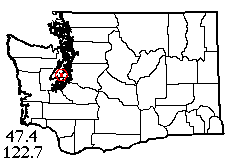 |
![]() 17 II 2015: I've successfully recruited a couple of new field volunteers, one of whom, Jessi Bishopp, actually came through with a good excursion. Jessi has a biology/natural history background mainly in Virginia and is very interested in learning about Northwest nature now that she's here. Big Pond Trail made a nice introduction for this glorious, rather warm February day. Although right next to a large housing development plunked down in the forest, all was pleasantly natural after the first few hundred feet of trail. The forest was largely western hemlock, with some mature trees, and dense understory of salal and evergreen huckleberry. But few habitats were reachable apart from said understory. Finally I spotted some alders far off to the right on a side trail that led to a logging road. I got a bag of litter to sift on a large boulder while Jessi beat the shrubs. A couple of guys from the local timber company came by looking for salal poachers. I had no idea that practice existed; there was sure plenty here to poach! Of course they were unconcerned about spider collecting. I got 8 species from the litter and Jessi added 4, including red-and-black Walckenaeria auranticeps, from the shrubs.
17 II 2015: I've successfully recruited a couple of new field volunteers, one of whom, Jessi Bishopp, actually came through with a good excursion. Jessi has a biology/natural history background mainly in Virginia and is very interested in learning about Northwest nature now that she's here. Big Pond Trail made a nice introduction for this glorious, rather warm February day. Although right next to a large housing development plunked down in the forest, all was pleasantly natural after the first few hundred feet of trail. The forest was largely western hemlock, with some mature trees, and dense understory of salal and evergreen huckleberry. But few habitats were reachable apart from said understory. Finally I spotted some alders far off to the right on a side trail that led to a logging road. I got a bag of litter to sift on a large boulder while Jessi beat the shrubs. A couple of guys from the local timber company came by looking for salal poachers. I had no idea that practice existed; there was sure plenty here to poach! Of course they were unconcerned about spider collecting. I got 8 species from the litter and Jessi added 4, including red-and-black Walckenaeria auranticeps, from the shrubs.
The pond was very full of water and all the marginal sedge had wet feet. Apparently all the nearby wet-meadow habitats were under water also; oh well. We made a stop at the extreme south end where a break in the canopy allowed me to beat some tree foliage, but it didn't add much. Jessi did better with beating shrubs right at the pond shoreline, getting a Dolomedes fishing spider! These have been very rare for most of my career, but may be getting commoner. Then on a side trail further along we found an area with some dead wood habitat, adding 3 more species; Jessi caught an unusual henicopid centipede here. As the trail squeezed between almost adjacent ponds, the hemlock forest gave way to more alder stands and a surprising scattering of white pines. I even tried for a pine cone sample, but the first cone got so much wet mud on my net that I gave up. The tree foliage here looked very promising but proved a disappointment. The side trail signed "Ledum Loop" was a misnomer, no Labrador tea in sight, just a couple of Spiraea marshes very full of water.
Having failed to find a single maple tree with that superior leaf litter, we stopped at the last big alder stand to sift some more alder litter, well worth while since it added about six species. Three more additions came from moss on the alder trunks, and three more from Douglas-fir foliage back at the trailhead. I estimate the loop trail we did around the long pond was about 2.5 miles, just enough to make winterized muscles nice and stiff next morning. End result of trip, 29-34 spider species where none were known before, nice natural scenery, and peaceful – almost no humans until after school let out in late afternoon. Two cool factoids: some spring spiders are already maturing in this warm winter; and there are almost no introduced spiders on Big Pond Trail (yet), only one specimen!
 |
![]() 22 II 2015: The great weather resumed after a brief break, and I picked a site farther south for my second trip with Jessi: Mason Lake, south of Hood Canal. The lake is almost entirely house-lined (poor fish, with all those septic tanks) but has a small county park at the east end and a large tract of working forest adjacent. We started in the park and promptly took 4 species from the walls of the closed restroom building. I sifted alder litter along the lake shore (since a picnic table was handy) while Jessi beat salal, and in an hour or so we were up to at least 19 spider species. A bit of dead-wood tapping gave us no mature spiders, but a narrow band of lake shore sedge produced six more including yet another fishing spider!
22 II 2015: The great weather resumed after a brief break, and I picked a site farther south for my second trip with Jessi: Mason Lake, south of Hood Canal. The lake is almost entirely house-lined (poor fish, with all those septic tanks) but has a small county park at the east end and a large tract of working forest adjacent. We started in the park and promptly took 4 species from the walls of the closed restroom building. I sifted alder litter along the lake shore (since a picnic table was handy) while Jessi beat salal, and in an hour or so we were up to at least 19 spider species. A bit of dead-wood tapping gave us no mature spiders, but a narrow band of lake shore sedge produced six more including yet another fishing spider!
Now we moved just outside the park boundary into a medium-aged clearcut, where Douglas-fir foliage brought us up to 33 species. The habitat appeared very grassy between the trees; grass wasn't coming up yet but a lot of the tree foliage spiders were grassland species, including vast numbers of Microlinyphia mandibulata. I got a nice pair of Ceraticelus fissiceps and Jessi got a male Clubiona trivialis here, plus an amazing find from broom, the weird crab spider Tmarus angulatus. With dirt bikes and target shooters audible, not as peaceful as the last trip but we can't complain about the spiders!
We moved a little way down the road to a finger of wetland that I'd thought might be sweepable, but we would have needed waders. However, teetering at the edge we pulled 2 small bags of moss off old alder trees. Even though many of the spiders sifted were juvenile, this still added 14 species including no less than 4 different Walckenaeria, and lots of the tiny wetland specialist Eulaira arctoa. We walked as far as the next road intersection to sweep a tract of grassy verge, but this added only one species not in the clearcut. However, a bag of upland alder litter gathered on the way back, and sifted as the sun sank to the horizon, gave us 2 more species for an amazing grand total of 51! I think this is my most diverse catch from a February trip, ever. An exceptional sunset over Hood Canal painted this red-letter day in rosy hues.
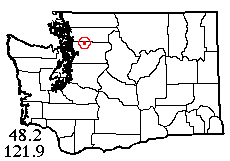 |
![]() 1 III 2015: On the (wrongly) predicted final day of the good-weather spell, I initiated another new volunteer, Audrey Zehren. My plan was to check spider fauna at a mountain site in this nearly snowless winter, so we headed for the washed-out Index-Galena Road up the North Fork Skykomish River. We saw some snow on Mount Index but not much. The end of the road was just past Trout Creek, as expected. But we didn't expect the temperature to be 39°, or the habitats to be soaking wet, or most tracts of supposedly public land on the east side of the creek to be posted private! With great reluctance I had to bail out of attempting to get a sample here. And I couldn't come up with a viable alternate plan on the Stevens Pass highway. So (after burgers at Zeke's) we drove all the way back to the lowlands and headed north to the Mountain Loop (where we should have gone in the first place). I figured we needed to stop at the closest possible place in order to have time to collect, so we left the highway a mile west of Oso to park by an unimproved section of the Whitehorse Trail (former railroad), arriving about 1:20 PM.
1 III 2015: On the (wrongly) predicted final day of the good-weather spell, I initiated another new volunteer, Audrey Zehren. My plan was to check spider fauna at a mountain site in this nearly snowless winter, so we headed for the washed-out Index-Galena Road up the North Fork Skykomish River. We saw some snow on Mount Index but not much. The end of the road was just past Trout Creek, as expected. But we didn't expect the temperature to be 39°, or the habitats to be soaking wet, or most tracts of supposedly public land on the east side of the creek to be posted private! With great reluctance I had to bail out of attempting to get a sample here. And I couldn't come up with a viable alternate plan on the Stevens Pass highway. So (after burgers at Zeke's) we drove all the way back to the lowlands and headed north to the Mountain Loop (where we should have gone in the first place). I figured we needed to stop at the closest possible place in order to have time to collect, so we left the highway a mile west of Oso to park by an unimproved section of the Whitehorse Trail (former railroad), arriving about 1:20 PM.
Hiking east on the rough trail about 300 meters, we found ourselves in a nice area with extensive marshland and alder swamp. Just one problem, it's severely invaded by Himalayan blackberry, except where too wet for the nasty vines (and for me). Blackberry blocked further progress, so we stopped at a concrete block (our sifting table) and penetrated the woods for a bag of swamp alder litter. Results were excellent, 7 cool species including several Pachygnatha dorothea and Saaristoa sammamish. Audrey was thrilled by all the varied spiders in this one bag of leaves! But a second bag added only one more species. I tried sweeping the marsh grass, but so much of it was laced with brambles that I only added 2 species (Tetragnatha caudata was unusually common here). And Audrey began suffering from what turned out to be a food allergy from that insidious burger, so I was on my own for the rest of the day.
Trying to keep to the trail right-of-way (100 feet wide) I found a little patch of dry woods with understory ferns (2 more species) and moss (4 more species). A solitary true-fir tree at the edge of someone's yard had no mature spiders. Back to Ramstad Road and walking about 500 m west on the trail, I found a few conifer branches to beat and some more extensive understory ferns and salal; also a neighbor's dog who got on the trail to bark at me. Given a couple of lucky finds besides the usual suspects, I had what later turned out to be 22 species. As it was getting dark, I scooped up a bag of maple litter for "insurance." Bad insurance, it proved to contain zero mature spiders! But I barely squeaked by with the 22-species sample. It was like a football game: the team didn't score at all in the first half, had a valuable player put out of action, then negotiated a very thorny path to narrowly snatch victory from the jaws of defeat. And we did get some good records…
 |
![]() 6 III 2015: Dry, sunny weather continued almost uninterrupted, and Jessi was available on Friday. Based on her need for a not-too-late return, we went south to Stan Hedwall Park in the outskirts of Chehalis, one of the largest chunks of public land in a place that needed fill-in collecting. Unfortunately, a lot of the habitats here are blackberry-invaded, but we did get a decent sample that we had to work hard all day for. Park buildings gave us 3 species and I got 6 more from a patch of juniper shrubs beside one building. At the edge of the "natural" area of the park was a row of maple trees, with most of the leaf litter buried under blackberry vines. I ultimately found enough for a bag-full to sift while Jessi headed down a trail signed "Scout Island" (not really an island) for vegetation sampling. The maple litter produced 7 spider species, the most interesting an atypical Phanias jumping spider.
6 III 2015: Dry, sunny weather continued almost uninterrupted, and Jessi was available on Friday. Based on her need for a not-too-late return, we went south to Stan Hedwall Park in the outskirts of Chehalis, one of the largest chunks of public land in a place that needed fill-in collecting. Unfortunately, a lot of the habitats here are blackberry-invaded, but we did get a decent sample that we had to work hard all day for. Park buildings gave us 3 species and I got 6 more from a patch of juniper shrubs beside one building. At the edge of the "natural" area of the park was a row of maple trees, with most of the leaf litter buried under blackberry vines. I ultimately found enough for a bag-full to sift while Jessi headed down a trail signed "Scout Island" (not really an island) for vegetation sampling. The maple litter produced 7 spider species, the most interesting an atypical Phanias jumping spider.
Down the "island" trail, Jessi had beaten shrubs and swept a grassy glade, adding 5 species. We gingerly tried to pick alder and cottonwood leaf litter from between thorny vines, but much of it had been drowned when the adjacent Newaukum River flooded; however, it added 2 species and the (somewhat muddy) moss on tree trunks added 4 more. Next we roved around beating isolated conifer trees in the park lawn before moving west into the right-of-way of the adjacent BN railroad tracks. Most of the spiders swept here (in nice-looking grassland with fewer blackberries) proved juvenile, but a Robertus under a log looks a little different from the usual R. vigerens.
We reached our last site, in the extreme southeast part of the park, on a short dirt road. Here there are some Garry oak trees among the maples, and a savanna-type habitat with sparse trees and grass. And, unfortunately, blackberries. The latter blocked access to the best conifer foliage and moss, but all habitats here added something (I got a nice record of Clubiona kastoni from the oak litter). I brought back a penultimate Pardosa that matured in 2 days; end result, 36 species. There wasn't much of a sunset today, but we got home with no substantial problems.
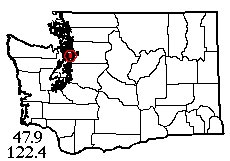 |
![]() 13 III 2015: My next solo-collecting day started with a bit of ill-luck: the Sound Transit driver taking me to Lynnwood drove so slowly all the other traffic was passing him. I ended up missing my connection to Mukilteo by seconds. However, after waiting a half hour, the next Mukilteo bus was right on time and I just squeaked onto the Whidbey Island ferry, catching the same Island Transit bus I'd originally planned on. My goal was a tract of county-owned forest land SE of Freeland, where I expected to have to bushwhack until I reached an old logging road that would take me south of the 48 degree line. Unexpectedly, the old road is now a foot-equestrian trail with a trailhead and everything. This trail, with few folks on it, took me through some quite nice forest habitat, near-mature hemlock with alder groves and no invasives. I settled down in a delightful, quiet, attractive spot that had litter, moss, understory, and a giant log to serve as a table.
13 III 2015: My next solo-collecting day started with a bit of ill-luck: the Sound Transit driver taking me to Lynnwood drove so slowly all the other traffic was passing him. I ended up missing my connection to Mukilteo by seconds. However, after waiting a half hour, the next Mukilteo bus was right on time and I just squeaked onto the Whidbey Island ferry, catching the same Island Transit bus I'd originally planned on. My goal was a tract of county-owned forest land SE of Freeland, where I expected to have to bushwhack until I reached an old logging road that would take me south of the 48 degree line. Unexpectedly, the old road is now a foot-equestrian trail with a trailhead and everything. This trail, with few folks on it, took me through some quite nice forest habitat, near-mature hemlock with alder groves and no invasives. I settled down in a delightful, quiet, attractive spot that had litter, moss, understory, and a giant log to serve as a table.
Understory beating here gave me a diverse spider fauna, ten species with little effort including a nice series of Linyphantes anacortes, plus one male of a Bathyphantes normally found in grassland. Considerable searching failed to uncover any deep leaf litter, but I got six more species from the alder leaves I was able to scrape up. Lots of moss, but sifting it added only 4 more species. The sun had almost burned through the overcast, then vanished again. Now I was ready to seek other environments to augment the not-quite-there sample of forest spiders. On down the trail, the improved section quickly gave out but a passable track (down which a jogger had preceded me) went on and on. I found some dense salal and beatable fir branches on the side of a ravine, but they weren't adding much.
I had no clue where this off-the-map trail was taking me, and didn't want to find myself in trackless woods when it got dark, so I returned to the trailhead and struck off down Craw Road and dead-end Coles Road in search of roadside field-type habitats. Not much luck! I walked a mile or more both ways without really finding what I wanted, but my hard work did pay off: a tiny tract of roadside grass barely tall enough to graze with the net, nonetheless gave me Tiso vagans and Linyphantes natches. Conifer branches, mainly cedar, that I could reach from the roadside added 3 more species and some Scots broom bushes had 2 of the grassland spiders I was seeking. Waiting for the very late homeward bus beside a very noisy highway was not so pleasant, especially when I discovered I was standing on an ant nest! But my trip, 3 bus systems and a ferry plus 4.7 miles on foot, got me a solid sample of 27 species, and the rest of Whidbey Island is now open to me on days with no driver!
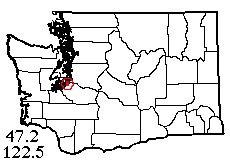 |
![]() 19 III 2015: There was one more dry-weather day before a predicted rainy spell, and no mid-week drivers, so I hopped a bus for Tacoma and changed to Pierce Transit for a park/natural area at China Lake, on the border between Tacoma and Fircrest. I knew it wouldn't be very peaceful because it's next to the Highway 16 freeway, but the noise wasn't too bad. The lake-shore loop trail started in a blackberry thicket, not boding well at all, but soon I was into a reasonably natural riparian forest. A side trail brought me down near a marsh on the shallow, northern part of the "lake" (really a pond), where I sifted alder-willow litter from the wetland edge for some time, getting 7 good spider species and assorted other creatures. There was considerable salal understory at my site, producing 7 more species for the beating net. Sweeping sedge added one more, and Pardosa ran for a few minutes when the sun almost burned through the overcast; one molted to maturity in my pocket on the way home.
19 III 2015: There was one more dry-weather day before a predicted rainy spell, and no mid-week drivers, so I hopped a bus for Tacoma and changed to Pierce Transit for a park/natural area at China Lake, on the border between Tacoma and Fircrest. I knew it wouldn't be very peaceful because it's next to the Highway 16 freeway, but the noise wasn't too bad. The lake-shore loop trail started in a blackberry thicket, not boding well at all, but soon I was into a reasonably natural riparian forest. A side trail brought me down near a marsh on the shallow, northern part of the "lake" (really a pond), where I sifted alder-willow litter from the wetland edge for some time, getting 7 good spider species and assorted other creatures. There was considerable salal understory at my site, producing 7 more species for the beating net. Sweeping sedge added one more, and Pardosa ran for a few minutes when the sun almost burned through the overcast; one molted to maturity in my pocket on the way home.
Moving down the trail, I passed an area with enough moss for 2 small sifting loads (added 4 species). What looked like accessible fir foliage from across the pond turned out to be a Scots broom stand but that, too, added a couple of species. Back near the park entrance, I got 4 more from Douglas-firs at the edge of the lawn. Lots of dog-walkers in this area! One chap introduced me to his friendly dog Josie, oddly enough the same name as my new cat.
Now, hoping to get an array of different species from new habitats, I headed a few blocks down the street to Tacoma Community College, where aerial photos show a natural area nearly covering the east half of the property. Oddly enough this habitat area is virtually unmentioned in public documents and websites, though it has public trails much in use by (guess what) dog-walkers. There are enough ponds to qualify it as quasi-wetland but much of the area is a vast sea of salal, sort of a salal prairie. However, beating this got me nothing new, and I had the same luck with the foliage of several promising-looking fir trees. Back near the trailhead on 19th Street there was some more varied habitat made hard to negotiate by very thorny hawthorn trees and blackberries, where I got one more species from grass and a second from the one fir tree there that wasn't full of thatching ants. Coming home, I carried a solid if unspectacular sample of 26-27 species, about the same as the last trip.
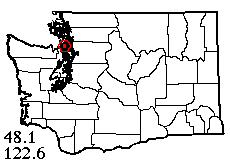 |
![]() 9 IV 2015: After 3 weeks of frequent "April showers," a collecting weather window appeared, but in mid-week when no volunteers could drive. So I used my second Whidbey Island bus trip plan. This time my bus luck was better than I perhaps deserved: I was out at the bus stop early, caught the late prior bus instead of the one I planned on, and got on the Mukilteo bus a half hour earlier than planned, thus making an earlier ferry, and actually catching the Island Transit bus in Clinton instead of missing it because their new spring schedule wasn't posted on the web site! For safety's sake the driver had to drop me off 0.7 mile from where I wanted, not too bad of a walk except for the very narrow shoulders on this highway. But before long I was at Rhododendron County Park, in brilliant sunny weather.
9 IV 2015: After 3 weeks of frequent "April showers," a collecting weather window appeared, but in mid-week when no volunteers could drive. So I used my second Whidbey Island bus trip plan. This time my bus luck was better than I perhaps deserved: I was out at the bus stop early, caught the late prior bus instead of the one I planned on, and got on the Mukilteo bus a half hour earlier than planned, thus making an earlier ferry, and actually catching the Island Transit bus in Clinton instead of missing it because their new spring schedule wasn't posted on the web site! For safety's sake the driver had to drop me off 0.7 mile from where I wanted, not too bad of a walk except for the very narrow shoulders on this highway. But before long I was at Rhododendron County Park, in brilliant sunny weather.
The restroom building was far too clean: no spiders or webs! But I made my way to a rough clearing north of the playfields, and soon was busily beating Douglas-firs around the edge of a forest rich with rhododendrons in the understory. Result, 9 spider species, not including a mysterious near-black Cyclosa that turned out to be juvenile. After adding 4 from salal foliage, I was just sucessfully chasing some wolf spiders on rough, grass-covered earth fill when the pilots at the nearby Navy airfield had a practice session. It's hard to collect with your fingers in your ears, and moreover the spiders themselves stopped running for the duration (fortunately under an hour). The Growler fighter jets have a surprisingly Diptera-like silhouette. I left this site with 15 species, and added a Cybaeus eutypus from under wood chunks on my way out. Now, I wanted some leaf litter and that proved to be in short supply! The first alder grove I checked out had not one leaf on the ground that I could see. The second grove, near the playgrounds, was almost as bad for litter but did have good moss on the trees, plus picnic tables to sift it on: a decent sample of moss spiders resulted, with a surprising number of Cybaeota (I normally get one or two).
Still seeking leaf litter I crossed the road to Patmore Pit Park (a playground for pampered pooches), where I was able to scoop up a bag of very scanty litter that nevertheless added five species. With the sun sinking, I made one more stop at a state "pheasant management area," where sweeping in grassland added another five species (even though I somehow lost one species I was sure I had). Despite various lacks, a nice worthwhile total of 31 species for the day. And I met a very nice woman on the bus trip home.
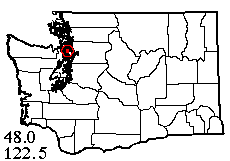 |
![]() 16 IV 2015: Another week, another window of nice weather. Driver availability was uncertain so I decided to try one more Whidbey Island trip on Thursday. My goal was a street that appeared to give back door access to the Trillium forest preserve — which has no bus access to its regular entrance. But as the obliging Island Transit driver slowly went along the stretch where this phantom intersection was shown, it never appeared! So I had to fall back on a makeshift contingency plan, and took a trail across the road from a local park, ascending through mature conifer forest to a large alder stand, which actually contained substantial leaf litter deposits unlike the alders I'd found last week, plus a stretch of clear mossy forest floor to sift on.
16 IV 2015: Another week, another window of nice weather. Driver availability was uncertain so I decided to try one more Whidbey Island trip on Thursday. My goal was a street that appeared to give back door access to the Trillium forest preserve — which has no bus access to its regular entrance. But as the obliging Island Transit driver slowly went along the stretch where this phantom intersection was shown, it never appeared! So I had to fall back on a makeshift contingency plan, and took a trail across the road from a local park, ascending through mature conifer forest to a large alder stand, which actually contained substantial leaf litter deposits unlike the alders I'd found last week, plus a stretch of clear mossy forest floor to sift on.
I sifted alder litter for some time, at first getting very little, but eventually felt that I'd taken at least 6 microspider species. No such luck, it was only 4: all the most promising specimens turned out to be one species, Ceratinops inflatus. Pretty far back in the woods to have such low diversity, who knows why? Fortunately there was plenty of moss in the stand and that added 7 species, with 5-6 more from the fern-dominated understory. Grass that I swept back beside the trail added 2 more including my old friend Tiso vagans. I was hoping for some salal understory, which usually has some different spiders, and after wandering through the woods for about a mile, I finally found one short stretch of it (about 20 m of salal and evergreen huckleberry) which indeed added two species.
Down on Smugglers Cove Road (no, there's no Smugglers Cove anywhere near), I walked south for a ways sweeping roadside verge grass and beating roadside conifers, staying within the right-of-way since I wasn't sure who owned the adjacent land. Not very diverse here either, but it did add 5 species. Finally, back near the bus stop, I looked behind boards up against some park buildings and located a Callobius severus so magnificent it would have scared an arachnophobe into fits. No friendly women on the bus this time, but I had about 28 spider species to show for the day.
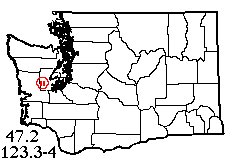 |
![]() 3 V 2015: Finally one of my field drivers (Audrey Zehren) was available on a beautiful weekend! We celebrated with a double-header of a trip plan, both sites on the south edge of the Olympic peninsula. Driving west from Shelton brought us to Matlock (near where I had a 19-species sample from way back in 1972). South of town, a logging road, gated an easy 0.6-mile walk from our destination, brought us through bright sunshine to the eastern fringe of Deckerville Swamp. A pool in the clearcut teemed with tadpoles. We entered the woods at the clearcut edge but didn't get as far as the actual swamp before the habitats were just too good to pass up.
3 V 2015: Finally one of my field drivers (Audrey Zehren) was available on a beautiful weekend! We celebrated with a double-header of a trip plan, both sites on the south edge of the Olympic peninsula. Driving west from Shelton brought us to Matlock (near where I had a 19-species sample from way back in 1972). South of town, a logging road, gated an easy 0.6-mile walk from our destination, brought us through bright sunshine to the eastern fringe of Deckerville Swamp. A pool in the clearcut teemed with tadpoles. We entered the woods at the clearcut edge but didn't get as far as the actual swamp before the habitats were just too good to pass up.
I sifted rich, deep drifts of maple-alder-hemlock litter around massive old-growth stumps, getting 7 spider species in a bagfull. Also 2 laniatorid harvestmen that clearly weren't one of the common species. Could they be the long-lost, undescribed Pentanychus (now Briggsus) that was taken long ago near here and the specimen then destroyed? It looks possible, but I'll have to study them more carefully later. A short moss sift added 5 more species, and Audrey had harvested 10 from the fern understory, with Pocadicnemis especially numerous. Back at the clearcut edge, a lycosid, 2 thomisids and a Habronattus were active by the roadside, Audrey swept 7 more species from a little grass (including uncommon Cyclosa turbinata and Crustulina sticta) and I got 3 more from fir foliage. We only really needed to add 2 species to the old sample here, but the habitats seduced us into going way overboard. About 3 hours at this site brought us 34 spider species!
![]() After a corn-dog break at the Matlock Store, we found our next sampling area with equal ease, an area just north of Lake Nahwatzel that appeared very odd on aerial photos: a spur road reaches a small, circular treeless area, circles all the way around it and stops. I thought maybe it was a wetland. But no, just a clearing with slight signs of fire and 2 white crosses. Mysterious! But some after-the-fact research reveals that on 24 July 2008 a small plane crashed and burned here; firefighters from 11 fire districts and the DNR quickly responded and contained the fire to 2 acres, but the 2 fliers died. They couldn't ask for a better memorial than the fine habitat that has grown up here in only 7 years!
After a corn-dog break at the Matlock Store, we found our next sampling area with equal ease, an area just north of Lake Nahwatzel that appeared very odd on aerial photos: a spur road reaches a small, circular treeless area, circles all the way around it and stops. I thought maybe it was a wetland. But no, just a clearing with slight signs of fire and 2 white crosses. Mysterious! But some after-the-fact research reveals that on 24 July 2008 a small plane crashed and burned here; firefighters from 11 fire districts and the DNR quickly responded and contained the fire to 2 acres, but the 2 fliers died. They couldn't ask for a better memorial than the fine habitat that has grown up here in only 7 years!
Two wolf spider and two salticid species were active on the ground, including unexpected Habronattus hirsutus (I'd expected H. oregonensis). The conifer foliage around the rim was very rich, with 14 species including very uncommon Entelecara sombra and Theridion differens. Just a little grass-sweeping got Audrey 9 species! And that doesn't count some native orbweavers too young to identify. This was her first time at vegetation sampling, so she's either very lucky or has a natural knack for finding good spiders. She even got 7 species from just beating a couple of Scots broom bushes, including a mature Phidippus!
Finally we went to a nearby site close to the lake shore, seeking something to sift. But litter was in short supply; and full of ants in the first 2 places I tried. Finally some better-seeming alder litter gave me only 1 species. Moss sifting was much better, adding 8 species for the site. Audrey happened to be wearing rubber boots, so I had her sweep a standing-water marsh on the lake shore, yielding 3 Tetragnatha species including very uncommon T. pallescens. Collecting along the path to the lake's best bathing beach gave me a nice view as several scantily clad young ladies went by. Since Audrey needed to work the next day, we left with daylight still remaining, but with 39 spider species from Nahwatzel in our vials.
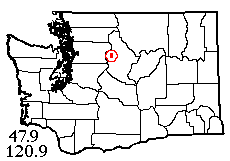 |
![]() 10 V 2015: Audrey was available the second Sunday in a row, and since rain clouds were supposedly on their way, we headed for eastern Washington. I'd forgotten it was Mother's Day, but Audrey has a mother and needed to get back not so very late, so I modified my original plan to a trip up the Chiwawa River to complete another of the partial samples Laurel Ramseyer got from pine cones in July 2011.
10 V 2015: Audrey was available the second Sunday in a row, and since rain clouds were supposedly on their way, we headed for eastern Washington. I'd forgotten it was Mother's Day, but Audrey has a mother and needed to get back not so very late, so I modified my original plan to a trip up the Chiwawa River to complete another of the partial samples Laurel Ramseyer got from pine cones in July 2011.
Not having done my homework on the Chiwawa River Road, I had no idea it is now closed at least 5 miles from my intended goal! So much for that, back to Lake Wenatchee (a.k.a. the drawing board) and a spur-of-the-moment trip up the White River (other end of the lake) to Grasshopper Meadows Campground. The campground seems to be semi-abandoned, and the meadow (if it ever truly was one) overgrown with shrubs and aspens, but it looked like a nice spot to spend the day, no other people around at all. The sky was almost cloudy, with the sun barely visible through haze and no sunscreen needed.
I first got 2 species from the outhouse, then moseyed down to the banks of the White River where a not-quite-adult Callobius and one harvestman were all I found from turning rocks. One wolf spider species was active. Understory sweeping was more successful, even though the spiders were sparse; between us we got 10 species, raising the total to 13. Audrey also tried vine-maple foliage, which practically duplicated the understory sample. I had some luck from dead-wood sampling, but it only added one good species. I then headed for the overgrown meadow, finding it easiest to work my way through the forest along the edge before penetrating into a more open area. Here, I had some little luck from sparse grass and much foliage of grand fir along the edge. I brought litter back to the picnic table from a small grove of bigleaf maple, adding 3 species including a nice Cybaeopsis, but we still had only 20-22 species.
We moved slowly back down the road in search of a supplemental site with other habitats, and found one! Roadside verge grass here added 5 species to my sweeping, the cottonwood litter had 5 that were all different from the earlier litter sample, and as a nice bonus, there was a rockslide habitat that I'd never noticed until we were out of the car, where I set Audrey to turning rocks. (I warned her to dodge if the truck-sized rock hanging over the middle started to move). This added 4 species including the pine-cone spider Euryopis formosa, and the best spider of the trip, Apostenus ducati recently described from Canada (I think this is the southernmost record). One disappointment, a small black jumping spider, possibly a rare Euophrys, was juvenile. But this gave us 32-34 species from a new area, a successful day after all.
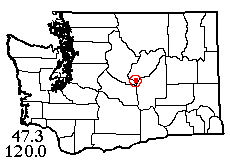 |
![]() 15 V 2015: Laurel Ramseyer, my 2008-2011 field volunteer, is back in Seattle! The first local field trip of her resumed career was planned to supplement 2 partial samples recently received from Wenatchee-area orchards. The first, with 14 species already, shouldn't (I thought) take long, leaving us most of the day in a higher elevation site where Laurel could tap her beloved pine cones.
15 V 2015: Laurel Ramseyer, my 2008-2011 field volunteer, is back in Seattle! The first local field trip of her resumed career was planned to supplement 2 partial samples recently received from Wenatchee-area orchards. The first, with 14 species already, shouldn't (I thought) take long, leaving us most of the day in a higher elevation site where Laurel could tap her beloved pine cones.
We reached our first site with little trouble: Dry Gulch, a canyon draining into the Columbia across the Malaga-Colockum Road. However, collecting beside the road produced sparse results. We got little from vegetation, mostly duplicating species from the orchard sample, and (as it turned out) nothing mature from under rocks. Finally we decided to give up here and hike down alongside the canyon to moister habitats by the river. Seeds of the abundant, invasive cheat-grass made this decidedly uncomfortable for anyone with shoes and socks on, but we made it. And we were rewarded! Several additional species were sweepable here, Laurel got adult Pardosa tristis along the shoreline and Phanias watonus from a mulberry bush (no weasel running around it), and I got several species under rocks in the shade. Add a couple of different jumping spiders from the upland site, and we had 15 species for the day, 26 with the prior records. Though sunny, the weather was so moderate I didn't even get thirsty. However, this had taken much, much longer than I'd planned! Laurel titled her photo album for the day, "Dry Gulch No-Cone Blues."
Now we navigated up to the planned site on Jumpoff Ridge, a bit complicated to drive but we managed it with no wrong turns. This site, at 3400' elevation, was lush and green and had plenty of Ponderosa pines. Alas for Laurel, most of the fallen pine cones weren't open. In the short time we were here, I added 8 species from lush, balsamroot-flowered meadows and fir trees to the 7 orchard records for a total of 15, but we'll need some more. Laurel was getting tired so we didn't even try to reach nearby Laurel Hill. We were both equal to the highly-filling product of E-Z's Burger Deluxe in Wenatchee before we started for home.
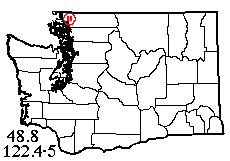 |
![]() 24 V 2015: Della Scott, long-time friend and volunteer, had the use of a car for a few days. Iffy weather reports finally settled down to merely "cloudy" so we took off, rather on the spur of the moment, for field destinations north of Bellingham. Wise decision — it cleared off for us soon after we arrived, while still cloudy in Seattle. Our first site was an undeveloped, proposed park (Van Wyck Park) on the west slope of King Mountain, really a medium-small hill. I had 12 species from this area from various sources including a brief stop with Hannah last year. Today we had plenty of time and decent habitats: a sizable clearcut, never replanted, has grown into quite a nice meadow, with no broom and hardly any blackberry! Spider fauna not unusually diverse, but it didn't take too long for sifting, sweeping and Pardosa-chasing to bring the gridspace sample up to 24 species. Tent caterpillars were much in evidence, but not in extreme plague mode. The top of the meadow had a view; and not another soul around, in the middle of Memorial Day weekend.
24 V 2015: Della Scott, long-time friend and volunteer, had the use of a car for a few days. Iffy weather reports finally settled down to merely "cloudy" so we took off, rather on the spur of the moment, for field destinations north of Bellingham. Wise decision — it cleared off for us soon after we arrived, while still cloudy in Seattle. Our first site was an undeveloped, proposed park (Van Wyck Park) on the west slope of King Mountain, really a medium-small hill. I had 12 species from this area from various sources including a brief stop with Hannah last year. Today we had plenty of time and decent habitats: a sizable clearcut, never replanted, has grown into quite a nice meadow, with no broom and hardly any blackberry! Spider fauna not unusually diverse, but it didn't take too long for sifting, sweeping and Pardosa-chasing to bring the gridspace sample up to 24 species. Tent caterpillars were much in evidence, but not in extreme plague mode. The top of the meadow had a view; and not another soul around, in the middle of Memorial Day weekend.
Having several hours of daylight left, we headed west for a Department of Wildlife site on the banks of the lower Nooksack River, just a couple miles above its mouth. A trail along the riverside dike here accesses splendid habitats. I only got one spider species from the dry alder litter, but sweeping the riparian meadows, after a slow start, eventually netted 11 species, including several of the rare-in-Washington Larinioides cornutus. Concrete sides of the Nooksack bridge gave me Larinioides sclopetarius and Salticus scenicus. Then, with the sun sinking, I went to beat foliage of the many young Sitka spruces growing along the wooded part of the dike trail. This brought me 19 spider species, including some interesting finds. Some Cyclosa conica specimens were rather atypical; I'll have to check them further. Hardly anyone around. In all, 29 species in under 3 hours, and we were off before 8:00.
As often happens, the most curious thing was common species I did *not* find. Several meadow species were curiously absent at the first site (no Tibellus, Neottiura or Xysticus); at the Nooksack, zero Misumena anywhere, including a stand of yellow flowers, and the diverse conifer sample lacked some very expected species. None of these species was missing at *both* sites!
Unfortunately, after we'd been driving a while, I discovered my camera (bought less than a year ago to replace a lost one) was not in its pocket! Kind-hearted Della turned around and returned to the river site just at dusk, wasting over an hour, where we searched in vain for it. Later that night I discovered I'd absent-mindedly put it in my shirt pocket! (Who knew a camera would even fit there...)
 |
![]() 30 V 2015: I had offered to participate, weather permitting, in the Bainbridge Island Land Trust's first BioBlitz. After some brave talk, no Scarabs elected to join me, but I got on the ferry where land steward Avery Bowron instantly recognized me by my net and pith helmet. Soon we were on our way to Gazzam Lake Nature Preserve, the trust's biggest parcel, mainly on the plateau of one of the island's taller hills. Starting at the south-end parking lot, our trail passed an old water tower and went a short distance downhill into the beginning of a nice bigleaf maple stand. Here, we had phenomenal luck, getting 11 mature spider species this late in the season, 24 species in all of all the creatures I collect, just from maple litter. After moss-sifting and fern-beating, we had 23 spider and 38 "everything" species — just at our first site!
30 V 2015: I had offered to participate, weather permitting, in the Bainbridge Island Land Trust's first BioBlitz. After some brave talk, no Scarabs elected to join me, but I got on the ferry where land steward Avery Bowron instantly recognized me by my net and pith helmet. Soon we were on our way to Gazzam Lake Nature Preserve, the trust's biggest parcel, mainly on the plateau of one of the island's taller hills. Starting at the south-end parking lot, our trail passed an old water tower and went a short distance downhill into the beginning of a nice bigleaf maple stand. Here, we had phenomenal luck, getting 11 mature spider species this late in the season, 24 species in all of all the creatures I collect, just from maple litter. After moss-sifting and fern-beating, we had 23 spider and 38 "everything" species — just at our first site!
Next, we visited a couple of small meadows (not trashed by blackberry yet, but in danger of it). I had high hopes of equal good luck from grass-sweeping and conifer-beating, but these sites were long past peak spider diversity. I only swept 3 mature species (no Tetragnatha or Tibellus, even, and no active wolf spiders) and the conifers only added 2; plus some juveniles countable for BioBlitz purposes. Here, Avery had to leave for another assignment but attractive volunteer Molly Esteve joined me as guide and recorder for the next while. We found our way to the preserve's central feature, marshy Gazzam Lake, where I hoped to access wetland habitats. Vain hope! There are only about 3 points to access the shore, and reportedly the bottom is too mucky to go much farther even if I'd had waders! (A canoe would have come in handy). However, there was some good salal habitat here (the first beat added 4 species), and by following a log out into the Spiraea zone I got my best specimens of the day, including my second record ever of Hypomma marxii!
By 5:30 I was at a junction not far from where I was to meet blitz coordinator Becca Nissley, my ride back to the ferry, at 7. A trail to the beach beckoned, and I thought, beach habitats should add a number of species. Big mistake! Most of the preserve's habitats are in decent to excellent shape, but not at the beach! Practically all the natural beach vegetation is replaced by ivy and blackberry. Beating did get 10 species here but only 2 (plus one enigmatic juvenile Lepthyphantes) not found elsewhere. By the time I'd slogged back up the 380' of elevation from sea level, it was time to meet Becca. Got 36 identifiable spider species for the day, but managed to record over 70 species of everything for the BioBlitz. Imagine what a whole team of "bug people" could have accomplished!
 |
![]() 6 VI 2015: Laurel was at loose ends for a 4-day period, so we planned two trips to pine country 3 days apart. The first was to the Cooper River, a tributary of the Cle Elum River that I'd never seen. Our first stop was the trailhead for Red Mountain Trail, supposedly paved with pine needles — make that fir needles, but there were enough white pines across the road to give Laurel a 55-cone sample for her pine cone studies. It was a good sample too, with 9 spider species (4 identifiable, one of them not yet identified). Meanwhile I had done well with a 12-species sample from conifer foliage. But there wasn't much more at ground level at this dry, 2600' elevation site, so next we tried a side road climbing alongside Stave Creek, allegedly washed out but actually not too hard even for a town car. Our site at 3700' elevation had a brook cascading down a steep rocky "meadow" where sweeping added several species (including a jumping spider I can't quite figure out), and I got a late-season Pardosa under a wood slab in the creek bed. Laurel even found 22 pine cones here to beat, with 5 spider species including Poeciloneta lyrica.
6 VI 2015: Laurel was at loose ends for a 4-day period, so we planned two trips to pine country 3 days apart. The first was to the Cooper River, a tributary of the Cle Elum River that I'd never seen. Our first stop was the trailhead for Red Mountain Trail, supposedly paved with pine needles — make that fir needles, but there were enough white pines across the road to give Laurel a 55-cone sample for her pine cone studies. It was a good sample too, with 9 spider species (4 identifiable, one of them not yet identified). Meanwhile I had done well with a 12-species sample from conifer foliage. But there wasn't much more at ground level at this dry, 2600' elevation site, so next we tried a side road climbing alongside Stave Creek, allegedly washed out but actually not too hard even for a town car. Our site at 3700' elevation had a brook cascading down a steep rocky "meadow" where sweeping added several species (including a jumping spider I can't quite figure out), and I got a late-season Pardosa under a wood slab in the creek bed. Laurel even found 22 pine cones here to beat, with 5 spider species including Poeciloneta lyrica.
As planned, we next stopped at the Cooper River Trail, going down-river just below Cooper Lake. I was hoping to find good riparian meadows here, but didn't. However, the scattered old-growth hemlock trees had siftable needle litter under them which gave me 5-6 species, plus one more from the understory. Meanwhile, Laurel added 4 good species from various habitats near the river bridge. I still hungered for a real meadow, so we headed for one last stop, which due to an overgrown road involved a mile's hiking. This did get us to a real meadow (even though not the one originally intended), but we had to cut our sweeping short because the mosquitos, absent until now, suddenly came out in ravening multi-species hordes! Anyway, we got 37 species from this formerly pristine area, including some very good records.
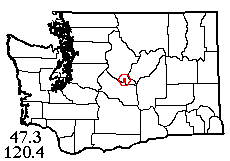 |
![]() 9 VI 2015: In what passes for a heat wave in Washington, I let Laurel pick the spot from 3 options. She picked what was probably the hottest, in the Mission Creek drainage south of Cashmere. The Forest Service website had said Road 7100 was open as far as the junction of 7101, but didn't mention that it's altogether decommissioned past that point! So we stopped there (at the mouth of Peavine Canyon) where a trickle creek meets the well-filled east fork of Mission Creek, while the dry slopes above were covered with Ponderosa pine for Laurel's cone project. About 4 passing bikers were the only humans we saw there, and nearly all flies were non-biting, at least in the heat of the day. Several patches of grass and herbs looked sweepable and I had very good luck with sweeping: 11 identifiable species, including a new state record for the exceedingly rare Chrysso nordica! I got 2 nets-full of alder litter by the creek and thought the sifting was OK, but later found I had only 2 litter-spider species. However, beating stream-bank foliage added 5 more different species, bringing me up to 18.
9 VI 2015: In what passes for a heat wave in Washington, I let Laurel pick the spot from 3 options. She picked what was probably the hottest, in the Mission Creek drainage south of Cashmere. The Forest Service website had said Road 7100 was open as far as the junction of 7101, but didn't mention that it's altogether decommissioned past that point! So we stopped there (at the mouth of Peavine Canyon) where a trickle creek meets the well-filled east fork of Mission Creek, while the dry slopes above were covered with Ponderosa pine for Laurel's cone project. About 4 passing bikers were the only humans we saw there, and nearly all flies were non-biting, at least in the heat of the day. Several patches of grass and herbs looked sweepable and I had very good luck with sweeping: 11 identifiable species, including a new state record for the exceedingly rare Chrysso nordica! I got 2 nets-full of alder litter by the creek and thought the sifting was OK, but later found I had only 2 litter-spider species. However, beating stream-bank foliage added 5 more different species, bringing me up to 18.
Meanwhile, Laurel had not been having it so good. No shortage of pine cones to tap, but 50 of them got her only 3 spiders, none identifiable to species. When we met in late afternoon she was starting to feel hyperthermic (it was probably over 90 on the slope where she'd been working, a weather station down-canyon reached 97 that day) despite drinking plenty of water. She agreed to a short period of tree-beating where each of us added one more species, and she got the 21st species from elderberry. I discovered a mysterious hiking trail, not shown on maps and destination unknown; Laurel glimpsed a skink. Then, for her health's sake, we had to leave this overheated but otherwise fine environment. A roadside stop on the way out got me one more species, for 22 total. The day ended pleasantly at Mountain High Hamburgers.
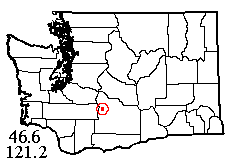 |
![]() 16 VI 2015: It was yet another trip with Laurel to pine country! This time we went down behind Mt. Rainier, over Cayuse and White passes and 6.4 miles down the east slope of U.S. 12 to the Sand Ridge trailhead. Here, although at 3400' elevation, there were some Ponderosa pines among the grand fir-Douglas fir forest. Temperature was moderate; only one other car in the parking lot. Laurel headed up the trail where she found a nice pine cone accumulation just out of sight of the trailhead picnic table, where I set up to beat fir foliage. Six species from the first tree, and 16 in all! Sweeping grass and understory got several species, but nothing new. Across the highway, though, was a marshy wetland (now mostly dry enough to walk on) where sweeping added 2 species and sparse alder litter got me one lonely Spirembolus.
16 VI 2015: It was yet another trip with Laurel to pine country! This time we went down behind Mt. Rainier, over Cayuse and White passes and 6.4 miles down the east slope of U.S. 12 to the Sand Ridge trailhead. Here, although at 3400' elevation, there were some Ponderosa pines among the grand fir-Douglas fir forest. Temperature was moderate; only one other car in the parking lot. Laurel headed up the trail where she found a nice pine cone accumulation just out of sight of the trailhead picnic table, where I set up to beat fir foliage. Six species from the first tree, and 16 in all! Sweeping grass and understory got several species, but nothing new. Across the highway, though, was a marshy wetland (now mostly dry enough to walk on) where sweeping added 2 species and sparse alder litter got me one lonely Spirembolus.
Now Laurel returned from her pine trees with a cone-beating sample of 10 spider species (5 identifiable), but oddly lacking the commonest cone spider Euryopis formosa – which I did get from tree foliage. We had each got one (different) species from aerial webs. To wrap up the site, I worked on the abundant fallen bark pieces on the forest floor (added Pimoa curvata and a Lepthyphantes not identified yet) while Laurel returned to her large pine trees to collect under scales of the unusually thick bark. This produced nothing adult, but one huge (penultimate) Callobius that is probably C. severus, though all the many other juveniles of this genus were something else.
There was a road on the map skirting the far side of that wetland across the highway, and I wanted to see what habitats it reached. We hadn't spotted it while driving in, but Laurel was willing to hike up and have a look. The old road was blocked (of course) but we were able to hike up it, getting the day's only wolf spider just after leaving the highway. We found nothing else likely to add more species to the list, but this route was a real botanical garden of local conifers: red cedar, two true fir species, Douglas-fir, western hemlock, spruce, two pine species and larch, all along the old roadside! We tried cutting directly across to the highway, past a trickle stream with lots of aromatic skunk cabbage, but at that point it was just a bit too mucky. So, back the way we came and homeward in daylight, treated to varied views of Mt. Rainier.
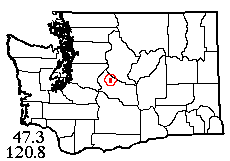 |
![]() 24 VI 2015: Today, both Laurel and Jessi were available for a properly staffed trip to the North Fork of the Teanaway River; Jessi drove, and we soon reached our first destination, 29 Pines Campground. There are a lot more than 29 pines there, but someone who named it must have been nostalgic for southern California. Jessi and I worked on vegetation sampling while Laurel tapped pine cones. Between us, we got only 5 species from field-sweeping, despite much field habitat available, but conifer foliage had all of 15 species; Jessi got some of the better specimens, including a male Ceraticelus, adult Philodromus oneida, and a yet-unidentified Theridion. Laurel's cone sample added little except an unexpected low-elevation Lepthyphantes mercedes, but she also added Bassaniana utahensis from pine-bark scraping.
24 VI 2015: Today, both Laurel and Jessi were available for a properly staffed trip to the North Fork of the Teanaway River; Jessi drove, and we soon reached our first destination, 29 Pines Campground. There are a lot more than 29 pines there, but someone who named it must have been nostalgic for southern California. Jessi and I worked on vegetation sampling while Laurel tapped pine cones. Between us, we got only 5 species from field-sweeping, despite much field habitat available, but conifer foliage had all of 15 species; Jessi got some of the better specimens, including a male Ceraticelus, adult Philodromus oneida, and a yet-unidentified Theridion. Laurel's cone sample added little except an unexpected low-elevation Lepthyphantes mercedes, but she also added Bassaniana utahensis from pine-bark scraping.
Jessi and I explored a bit and found a way across country to the banks of the river, preceded by a family of campers (one trying to sunbathe under the overcast sky). There, we added 2 species by sweeping and I brought back a bag of rather dry leaf litter that nonetheless added six more species.
Now we drove a few miles upriver on increasingly washboardy roads, to the trailhead for Johnson Creek at a footbridge across the
North Fork. At this higher elevation site, the river appeared more full, the conifer foliage had a few more species, and I got Walckenaeria helenae from bark on the ground. Blue sky finally appeared through the clouds. Laurel found that though we were just outside the ponderosa zone, white pines were present, and their cones added a nice Anyphaena. Heading homeward, we enjoyed our Mountain High hamburgers with at least 33 species from our selected area to show for the day.
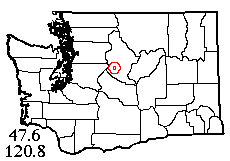 |
![]() 30 VI 2015: In view of last week's success, I thought we could risk one more mid-elevation trip on the east slope of the Cascades, selecting a site on upper Icicle Creek (well into the mountains but only 2700' in elevation) where Laurel had taken 4 species a few years ago. After a little exploring, we found that my intended Chatter Creek trail site seems to have moved, but we found another trail that parallels the road in the main valley of Icicle Creek. At the trailhead parking lot, lots of grassy field vegetation beckoned, but sweeping in the hot sun got not one identifiable spider! So we both headed down-trail to a more shady area near the footbridge across Icicle Creek. Here, Laurel found white pines with fallen cones to beat, while I located a solitary cottonwood tree whose litter produced spiders. The litter got me a nice sample of 6 species, including an unusual Zanomys and a very-likely-new, very tiny Blabomma. Unfortunately, Laurel's cone sample at the site was very smiliar to this and added nothing.
30 VI 2015: In view of last week's success, I thought we could risk one more mid-elevation trip on the east slope of the Cascades, selecting a site on upper Icicle Creek (well into the mountains but only 2700' in elevation) where Laurel had taken 4 species a few years ago. After a little exploring, we found that my intended Chatter Creek trail site seems to have moved, but we found another trail that parallels the road in the main valley of Icicle Creek. At the trailhead parking lot, lots of grassy field vegetation beckoned, but sweeping in the hot sun got not one identifiable spider! So we both headed down-trail to a more shady area near the footbridge across Icicle Creek. Here, Laurel found white pines with fallen cones to beat, while I located a solitary cottonwood tree whose litter produced spiders. The litter got me a nice sample of 6 species, including an unusual Zanomys and a very-likely-new, very tiny Blabomma. Unfortunately, Laurel's cone sample at the site was very smiliar to this and added nothing.
Some moss on rocks by the bridge also added nothing, nearby conifer foliage added 2, and buildings down the road added nothing! I went a ways upstream to a floodplain site I'd spotted earlier, where I added a total of 2 species from understory sweeping, and found nothing else mature. Back near the trailhead, conifer-beating near the solitary picnic table got me three more species. Laurel added none from ponderosa cones in the same area, and one orbweaver from an aerial web. So our day's work got us a miserable 14 species, making 18 with the older sample. Us for the high country after this!
A stop at our familiar Nason Creek Rest Area site did get some interesting stuff from another pine cone sample, including one area where Pholcophora americana was plainly reproducing in the pine cone habitat; 40 juveniles (and 2 adults) taken from only 25 cones!
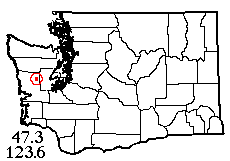 |
![]() 10 VII 2015: Contrary to resolutions, we staged another low elevation trip because thunderstorms were predicted in the mountains. This one, however, was in western Washington over toward the seacoast. I had made a trip plan combining a sample on the Wynoochee River (southern Olympic Peninsula) with a brief re-visit to Deckerville Swamp to get more of the new harvestman taken there May 3rd. It should have occurred to me (but didn't, until too late) that the private timberland including Deckerville Swamp might be closed due to extreme fire danger. It was! Even less expected was that this closure also extended to part of Cougar Smith Road on the "shortcut" from Matlock to the Wynoochee. Presto, another hour added to our travel time.
10 VII 2015: Contrary to resolutions, we staged another low elevation trip because thunderstorms were predicted in the mountains. This one, however, was in western Washington over toward the seacoast. I had made a trip plan combining a sample on the Wynoochee River (southern Olympic Peninsula) with a brief re-visit to Deckerville Swamp to get more of the new harvestman taken there May 3rd. It should have occurred to me (but didn't, until too late) that the private timberland including Deckerville Swamp might be closed due to extreme fire danger. It was! Even less expected was that this closure also extended to part of Cougar Smith Road on the "shortcut" from Matlock to the Wynoochee. Presto, another hour added to our travel time.
However, we did successfully reach our main goal, a bridge across the Wynoochee River about a mile SW of Wynoochee Dam. I hadn't realized this bridge is the site of a smaller, quasi-dam "fish collection facility" intended to give spawning fish a ride around the dam. The sides of the Forest Service road here were very dusty, so Laurel and I each sought our own "greener pastures" – in my case, up a gated side road that proved to lead to a large grassy field. Though most of the grass was dry (and with scattered dumped appliances, other refuse and even a small building in the trash pile), sweeping got me 7 identifiable spider species plus Phalangium opilio. And there was one lonely Pardosa vancouveri wolf spider left from the spring generation. At the upper end of the field, foliage of young Douglas-firs added 7 more species including the nice little orbweaver Neoscona arabesca. As I left the field, turning over a chunk of wood got me a mature Enoplognatha thoracica. Next, I spent some time in the adjacent alder-fir woodland, where I found no leaf litter but understory sweeping added 5 species and moss-sifting 2 more. Already up to 23 species!
Meanwhile, Laurel had collected along the bridge railings and found our seldom-seen, tube-dwelling Segestria pacifica. Next, she headed downstream on the far bank and just beyond the spillway, found a low bluff wet with seepage water she dubbed the "weeping wall." Foliage spiders here were somewhat earlier-season than those in the dry forest, and included some interesting Clubiona (one not yet placed, another killed by fungus). Laurel's conifer and roadside-verge beating in this area added a few more species including a Theridion not yet placed. Finally I located some leaf litter, adding 3 more for an impressive (for July) 36-species total.
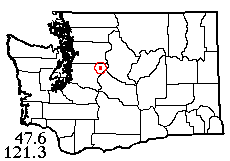 |
![]() 17 VII 2015: Visiting Finnish photographer Markku Savela joined Laurel and I (and provided the wheels) for a trip into the Cascades to the short trail to Evans Lake, SSE of Skykomish. We hoped the 3700' elevation, and adjacent water, would be enough to provide an adequate spider fauna – and it was. Markku stayed by the road where he photographed seven butterfly species (and assorted other cool insects there and at the lake); Laurel got a couple of others Markku missed. Meanwhile, in old-growth hemlock just short of the lake, I sifted 5 good spider species; in the same area, Laurel got one more from a rotten stump and two others (including subalpine Coreorgonal petulcus) from the tiny cones of mountain hemlock!
17 VII 2015: Visiting Finnish photographer Markku Savela joined Laurel and I (and provided the wheels) for a trip into the Cascades to the short trail to Evans Lake, SSE of Skykomish. We hoped the 3700' elevation, and adjacent water, would be enough to provide an adequate spider fauna – and it was. Markku stayed by the road where he photographed seven butterfly species (and assorted other cool insects there and at the lake); Laurel got a couple of others Markku missed. Meanwhile, in old-growth hemlock just short of the lake, I sifted 5 good spider species; in the same area, Laurel got one more from a rotten stump and two others (including subalpine Coreorgonal petulcus) from the tiny cones of mountain hemlock!
At the lake, Laurel and I sampled assorted types of foliage to boost the sample up to 20 species. It was hard to keep our minds on the job though, with two huckleberry species plus salmonberries all available in abundance! Back by the roadside, a small meadow next to a pond unexpectedly proved to be a Sphagnum bog, though dry enough to walk on; sweeping the sedge added one species and sifting the moss added two more.
In the last couple hours of the day we decided to climb nearby Sobieski Mountain (4400 feet) for some slightly higher habitats. The climb was accomplished entirely with Markku's car, on a better than expected road, maintained because of a radio facility at the top. Here, conifer foliage added 4 more species for a total of 27 for the day. We made it to Zeke's (Gold Bar) before closing time today and were all fully satisfied with our meal there.
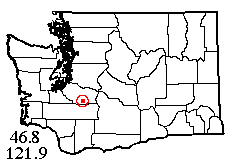 |
![]() 23 VII 2015: It was now definitely past time to start collecting at high elevations; indeed, we could have started weeks earlier in this nearly snowless year. Today Laurel and I headed for the Glacier View Trail just outside (the west side) Mt. Rainier park; Laurel's spouse Marie Rose came along for the hike. The long, rough road to the trailhead was almost too much for the new Prius, but not quite! The day was cloudy and cool, and lots of huckleberries gave us an energy boost on the trail. I stopped off just after passing the first (unnamed) peak on the three-peak ridge, while the others continued on to Glacier View proper. I began by tapping fallen wood and bark in the old-growth mountain hemlock & silver fir forest. Almost always productive in these high forests, this alone got me 9 species, with lots of Lepthyphantes rainieri, but including two Poeciloneta canionis (only one prior Washington record) and Washington's first P. theridiformis! P. canionis is a really beautiful little spider too. Sifting hemlock litter added 2 more species including an undescribed Blabomma. Conifer foliage in an adjacent patch of regrowth added two more species.
23 VII 2015: It was now definitely past time to start collecting at high elevations; indeed, we could have started weeks earlier in this nearly snowless year. Today Laurel and I headed for the Glacier View Trail just outside (the west side) Mt. Rainier park; Laurel's spouse Marie Rose came along for the hike. The long, rough road to the trailhead was almost too much for the new Prius, but not quite! The day was cloudy and cool, and lots of huckleberries gave us an energy boost on the trail. I stopped off just after passing the first (unnamed) peak on the three-peak ridge, while the others continued on to Glacier View proper. I began by tapping fallen wood and bark in the old-growth mountain hemlock & silver fir forest. Almost always productive in these high forests, this alone got me 9 species, with lots of Lepthyphantes rainieri, but including two Poeciloneta canionis (only one prior Washington record) and Washington's first P. theridiformis! P. canionis is a really beautiful little spider too. Sifting hemlock litter added 2 more species including an undescribed Blabomma. Conifer foliage in an adjacent patch of regrowth added two more species.
I knew there were meadows on the east face of this mountain (the trail skirts the west face), so I contoured around and managed to find a small glade, but not the big meadow. Bear scat here showed me I wasn't the only recent visitor. Sweeping and conifer-beating here brought me up to about 20 species. A second fallen-bark site, later in the day, got me one more for the minimum of 21.
Meanwhile Laurel and Marie Rose had gone the extra mile to climb Glacier View, but weren't rewarded (until the last moment) by any views of Mt. Rainier's glaciers, shrouded in clouds. However, Laurel's sweeping some mini-meadows she passed through added 2 species (one of them a more common Poeciloneta) and her conifer-beating on the higher peak added 2 more, so our day's total was 25. Laurel did beat hemlock cones (50) again, after last week's success, but the only identifiable spider was Lepthyphantes rainieri. On our way out, we had an hour to spare so I wanted to make one last effort to find that big meadow. I climbed to the ridge crest from the trail south of the summit (where the meadow, on the east slope, was supposed to be), but could see no trace of meadow looking down and eastward from the crest. I did get another fallen-bark sample while I was there. After the fact, I found that had I ascended a mere 130 meters along the ridge crest toward the summit, there would have been the meadow!
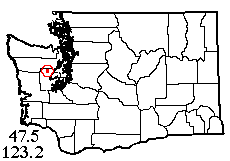 |
![]() 31 VII 2015: To escape the heat and still-increasing dryness, Jessi, Laurel and I headed for Mount Ellinor in the southeast Olympic Mountains. At this season, it's best to enhance sample diversity by collecting at multiple elevations, so we started at a roadside near Skinwood Creek at about 2000 feet elevation. Here I swept 6 species from the roadside while Laurel and Jessi added 3 others from conifers and aerial webs. At the upper trailhead for Ellinor, there was the cosmopolitan tepidariorum house spider on the outhouse, making a nice head start of 10 species.
31 VII 2015: To escape the heat and still-increasing dryness, Jessi, Laurel and I headed for Mount Ellinor in the southeast Olympic Mountains. At this season, it's best to enhance sample diversity by collecting at multiple elevations, so we started at a roadside near Skinwood Creek at about 2000 feet elevation. Here I swept 6 species from the roadside while Laurel and Jessi added 3 others from conifers and aerial webs. At the upper trailhead for Ellinor, there was the cosmopolitan tepidariorum house spider on the outhouse, making a nice head start of 10 species.
Next we hiked up the steep trail (often more resembling a stairway) to treeline, where I intended to collect from the small conifers and meadows. Amazing views abounded. The foliage here (mainly heather in the meadows) added 6 more species, with Laurel getting the best one (an undescribed subalpine Pityohyphantes). Meanwhile, Jessi had decided to actually climb the remaining thousand feet of elevation to the summit, where she got a nice Cybaeopsis from a miniature tree, and more species from a lusher meadow partway up. Laurel paused at some boulder talus slightly higher than my treeline site and added one Pardosa and a spectacularly large (and unusually black) Araneus gemmoides.
Meanwhile, I knew Jessi wanted to get home to sleep before work the next morning, so I headed back down to the 4400-foot level to do high forest collecting. The dead wood habitat wasn't as good as it had been the previous week but, ultimately joined by Jessi, we rounded up 8 species. Unnoticed by me (until Jessi pointed them out) a pair of mountain goats had come by and were following our activities with interest, a couple of times approaching rather too close for comfort. But they had vanished by the time Laurel came down and joined us. Now we worked at getting a conifer-litter sift sample, which added only one more species but also improved the series of Callobius nomeus – one of which bit my fingertip as I clumsily tried to poke her into a vial. A notable occurrence, since I've had only 2 prior spider bites in my entire career! Aside from the initial momentary stabbing sensation, the bite had no further effect. To escape the mosquitos, Laurel did some more conifer beating here, adding one more species for a total day's catch of 31. Hoodsport's Burger Stand offered a satisfactory end-of-hike meal.
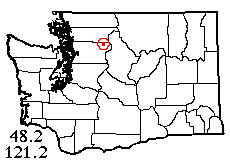 |
![]() 3 VIII 2015: Back in the 1970s and 80s, I made several trips up the Suiattle River (NE of Darrington). One unlucky visit (exactly 26 years ago) left me with a sample of 13 spider species. About 11 years ago, I planned to complete this sample with a hike up Green Mountain. Just then, the Suiattle road washed out. I just learned that the road was finally repaired, so Laurel and I headed up into the mountains for what may be my last field trip this summer. Our initial stop was at Green Mountain Pasture, a meadow at the mountain's base in the Suiattle floodplain. This must be an amazing place for spiders in the spring, because we had 17 species from here in under an hour even in August! Some highlights: native Neoscona orbweavers from the trees and native Araneus from the meadow; gnaphosids under wood in the grass and house spiders from a shed/barn.
3 VIII 2015: Back in the 1970s and 80s, I made several trips up the Suiattle River (NE of Darrington). One unlucky visit (exactly 26 years ago) left me with a sample of 13 spider species. About 11 years ago, I planned to complete this sample with a hike up Green Mountain. Just then, the Suiattle road washed out. I just learned that the road was finally repaired, so Laurel and I headed up into the mountains for what may be my last field trip this summer. Our initial stop was at Green Mountain Pasture, a meadow at the mountain's base in the Suiattle floodplain. This must be an amazing place for spiders in the spring, because we had 17 species from here in under an hour even in August! Some highlights: native Neoscona orbweavers from the trees and native Araneus from the meadow; gnaphosids under wood in the grass and house spiders from a shed/barn.
Then it was up the narrow but not-bad Green Mountain Road to the trailhead. Laurel got first blood (well, hemolymph) with an adult Zygiella dispar on the trail sign. 200 vertical feet higher, she found possibly the only white pine tree on the mountain, and beat 50 pine cones for 4 spider species and some cool pseudoscorpions. Meanwhile I had headed on up to my goal of subalpine forest at 5300 feet. This is a really great trail, despite languishing unused for over a decade! Smooth to walk, nice grades, gorgeous meadows and the most spectacular views you could ask for. Also, in the summer, vast hordes of grasshoppers and a certain (not excessive) number of biting flies.
Reaching my goal, I sampled dead wood and needle litter in the high tree grove, finding spiders to be sparse but good: 5 microspider species, plus adult Callobius that unfortunately got away. Young trees in a meadow just outside the grove also had decent spiders (at this point, Laurel caught up after about a 2-hour separation). While she beat mountain hemlock cones, getting nothing, I went back down into the main flower meadow and swept a couple more species, most notably Dendryphantes nigromaculatus. Hiking down, we met someone who knows my volunteer Hannah Dykstra. We were going to collect again just below treeline, when I discovered it was after 7 PM! I did have a flashlight, but on the whole we'd rather not hike down 2 miles of trail in the dark. Nothing completely new on this trip, but 32 species is a fantastic sample for August, and the old records from past decades give me 42 in all from the area.
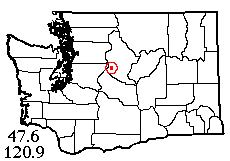 |
![]() 20 X 2015: I should have started fall collecting sooner, but revamping the Spider Myth Website for re-launch kept my nose to the grindstone. Based on forecasts, Laurel and I decided to try an east-slope trip today, over Stevens Pass and back to upper Icicle Creek where hard work got us only 15 species on 30 June. This time we started at an upper site (different grid-area), Blackpine Horse Camp just before the road ends. The road and some areas of ground were wet, but most foliage was thankfully dry. I immediately went hunting for leaf litter to sift. I could see cottonwoods turning beautiful bright yellow through the forest, but reaching them through the vine-maple and other brush was quite a chore, especially with the ground slippery with dew! It took hours to complete my sifting, but it was worth it, getting me 13 species in all, some very interesting.
20 X 2015: I should have started fall collecting sooner, but revamping the Spider Myth Website for re-launch kept my nose to the grindstone. Based on forecasts, Laurel and I decided to try an east-slope trip today, over Stevens Pass and back to upper Icicle Creek where hard work got us only 15 species on 30 June. This time we started at an upper site (different grid-area), Blackpine Horse Camp just before the road ends. The road and some areas of ground were wet, but most foliage was thankfully dry. I immediately went hunting for leaf litter to sift. I could see cottonwoods turning beautiful bright yellow through the forest, but reaching them through the vine-maple and other brush was quite a chore, especially with the ground slippery with dew! It took hours to complete my sifting, but it was worth it, getting me 13 species in all, some very interesting.
Meanwhile, Laurel had been combing the Blackpine camp for pine cones – should be a sure thing, right? – but similarly required hours of work to come up with only 45 cones. This was well worth it too, though, with 12 species (not all identifiable) and adding 6 not otherwise taken. Laurel and I tried the usual vegetation sampling with decidedly anemic results; good thing we weren't depending on that, though it did add 6 more species. In the course of the day, Laurel located a side trail down to Icicle Creek from one trailhead, presumably to water the horses, and streamside rock-turning added 4 more (2 rarities included) for 28 in all. Coyotes serenaded us at one point in the afternoon.
With daylight dwindling, we headed back down the road to the scene of our June failure, Chatter Creek. Here, the field where I could sweep nothing in June, once again yielded nothing to the net! However, 0.7 miles beyond we came to a promising-looking clearing at Chatter Creek Trailhead, where I swept some more natural grass while Laurel beat shrubs as the sun went behind the mountains. Again, the vegetation added nothing! However, I scooped up a bag of scrumptious-looking cottonwood litter and sifted it in the last light (partly by flashlight as an owl started hooting); this finally added 5 more species to the 19 from previous collections, so we did manage to bag the 2 recalcitrant areas today. Success is sweet! Several deer on the road completed the day's wildlife viewing.
 |
![]() 25 X 2015: I had one species, Bathyphantes brevipes, from a student collection near Everson, northern Whatcom County. To supplement this, Laurel and I visited Nooksack Cemetery, 5 miles from Canada, which (as usual with rural cemeteries) had adjacent accessible fields and woodland. I swept a dry-grass field off the NW corner, bagging 6-7 species and meeting a friendly landowner. Then I found some promising maple litter, which proved rich in everything but spiders! Ultimately the first maple litter site added 6 more species, more litter off the south edge of the cemetery added 2 more, and some willow litter by Breckenridge Creek added none! At least the weather was delightful, warm and partly-cloudy with gentle breezes, while it was raining in Seattle and nearly everywhere else.
25 X 2015: I had one species, Bathyphantes brevipes, from a student collection near Everson, northern Whatcom County. To supplement this, Laurel and I visited Nooksack Cemetery, 5 miles from Canada, which (as usual with rural cemeteries) had adjacent accessible fields and woodland. I swept a dry-grass field off the NW corner, bagging 6-7 species and meeting a friendly landowner. Then I found some promising maple litter, which proved rich in everything but spiders! Ultimately the first maple litter site added 6 more species, more litter off the south edge of the cemetery added 2 more, and some willow litter by Breckenridge Creek added none! At least the weather was delightful, warm and partly-cloudy with gentle breezes, while it was raining in Seattle and nearly everywhere else.
Meanwhile, Laurel toured the cemetery and found that the vertical gravestones and monuments (including the grave of town founder Ever Everson) had populations of Zygiella and Salticus scenicus, but also intercepted various ballooners from nearby woods and fields. While down by the creek, I swept a lush riparian meadow adding 3 more species. Ferns added 2 more. Conifer foliage, both from planted cemetery trees and a nice spruce just outside the grounds, added 2 more species. Laurel also got house spiders from an adjacent school building. By this point we had 28 species for the day.
Having an hour or so of daylight left, we drove around looking for more habitats – especially pine cones! Several area residents had planted pines in their yards, but there were either no cones, the cones had no spiders or there was nobody home to ask. Finally, a pasture with cone-rich ponderosa pines on both sides; Laurel had tapped 43 cones (7 species, adding one) and I'd found a hobo spider by the barn before the owner changed her mind about letting us collect. We escaped with a nice even 30 species, just in time. Black clouds closed in, preventing a sunset photo.
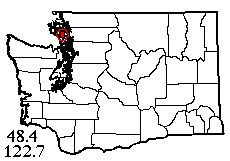 |
![]() 21 XI 2015: Missed opportunities and typical fall weather led to a long hiatus, but here were Laurel and I in the field again on a brilliantly sunny but somewhat chilly day. I selected Fidalgo Head, a headland west of Anacortes, hoping that full exposure to the westering sun would warm habitats. It worked! But the narrow slice of land west of 122.7° longitude proved to be very rocky, with no maples or alders and practically no understory under the Douglas-fir. However, there was plenty of the latter to beat so I started doing that, keeping it up until I estimated as many as 10 species in the bag. Really it was only 6. Next, I sifted 2 bags of fir litter (got 2 spiders per bag, but it added 2 nice species). Laurel had been beating Douglas-fir cones, and surprisingly this added 4 species, all linyphiids, plus 20 pseudoscorpions! In the process she spotted a deposit of madrona litter that saved the day. She also added a couple of species by sweeping the extremely sparse grass. On post-trip research, I discovered that the unusual, sparse forest vegetation has a cause: this is one of Washington's rare ultramafic (serpentine) rock habitats. Serendipity strikes again!
21 XI 2015: Missed opportunities and typical fall weather led to a long hiatus, but here were Laurel and I in the field again on a brilliantly sunny but somewhat chilly day. I selected Fidalgo Head, a headland west of Anacortes, hoping that full exposure to the westering sun would warm habitats. It worked! But the narrow slice of land west of 122.7° longitude proved to be very rocky, with no maples or alders and practically no understory under the Douglas-fir. However, there was plenty of the latter to beat so I started doing that, keeping it up until I estimated as many as 10 species in the bag. Really it was only 6. Next, I sifted 2 bags of fir litter (got 2 spiders per bag, but it added 2 nice species). Laurel had been beating Douglas-fir cones, and surprisingly this added 4 species, all linyphiids, plus 20 pseudoscorpions! In the process she spotted a deposit of madrona litter that saved the day. She also added a couple of species by sweeping the extremely sparse grass. On post-trip research, I discovered that the unusual, sparse forest vegetation has a cause: this is one of Washington's rare ultramafic (serpentine) rock habitats. Serendipity strikes again!
Sifting the cold leaf litter on-site added 4 species, but this showed it would be worthwhile to bring a garbage-bag-full home to warm up so the spiders would move. My flimsy garbage bag quickly developed a couple of holes, but on returning to the car I tripped over the edge of the road and the whole bottom (and most contents) fell out! Fortunately I had another bag! That wasn't the day's only pratfall; both Laurel and I slipped on the thin veneer of clay on the trails and abruptly sat down. Back in the forest, I sifted some moss on boulders and other rocks had some Neriene in webs, but nothing new. However, we came away with 23-25 species, including a possibly new Lepthyphantes from the warmed-up madrona litter and several unusual records.
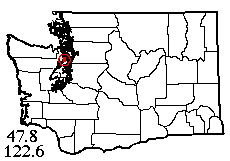 |
![]() 29 XI 2015: It was the predicted last day of the long dry, chilly period with temperature inversions at ground level. NOAA predicted our goal, Salsbury Point County Park near the Hood Canal Bridge, to have 100% blue skies, and I presumed habitats in the sun would be warm enough. So what do we get? Fog! Fog in Seattle, fog on the ferry, and fog-overcast all day at our destination. No sun, no warmth. Sifting moss got me one (juvenile) spider; I didn't even try sifting leaf litter but brought another bagfull home to warm up.
29 XI 2015: It was the predicted last day of the long dry, chilly period with temperature inversions at ground level. NOAA predicted our goal, Salsbury Point County Park near the Hood Canal Bridge, to have 100% blue skies, and I presumed habitats in the sun would be warm enough. So what do we get? Fog! Fog in Seattle, fog on the ferry, and fog-overcast all day at our destination. No sun, no warmth. Sifting moss got me one (juvenile) spider; I didn't even try sifting leaf litter but brought another bagfull home to warm up.
But on the plus side. I had 2 skilled helpers: Laurel and new volunteer Ben Diehl, recently of Texas A&M Entomology. The park had a nice variety of habitats, forest with lots of maple, varied conifers and understory, a shelter-restroom building with spiders, a playground with an orbweb-based jungle gym, a beach with some beach meadow and driftwood, a stand of shore pine dropping cones for Laurel, and some beach-front firs and spruces. All these (except the playground) produced spiders, 34-35 total species including 10 that I only got from the warmed-up bag of litter.
Ben got 8 species from understory ferns, 3 more from under logs, Ben and Laurel between them got 6 from the building, and I got about 12 from conifer foliage. My first sweep in the beach meadow got 3 species (2 not duplicated) but subsequent sweeps got nothing at all! Laurel's sample of 100 pine cones got her 4 spider species, only one identifiable, uncommon Tachygyna #4 (also taken from beach meadow, conifers, and ferns). Ben found one lonely spider under driftwood (I tried too but found nothing); but that one looks like the uncommon Spirembolus latebricola. A successful trip but if the forecast had been true, 'twould have been far more pleasant!
We didn't manage to get out in December — but stay tuned for 2016!
This page last updated 21 March, 2025